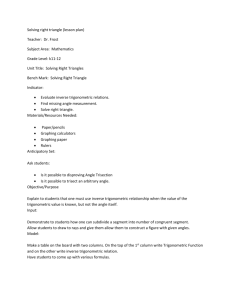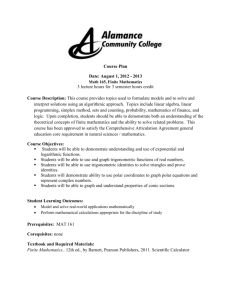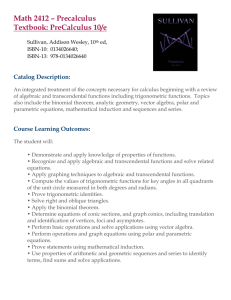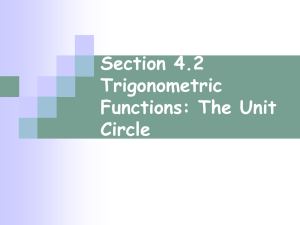Trig_Dual-Master_Spring 2015
advertisement
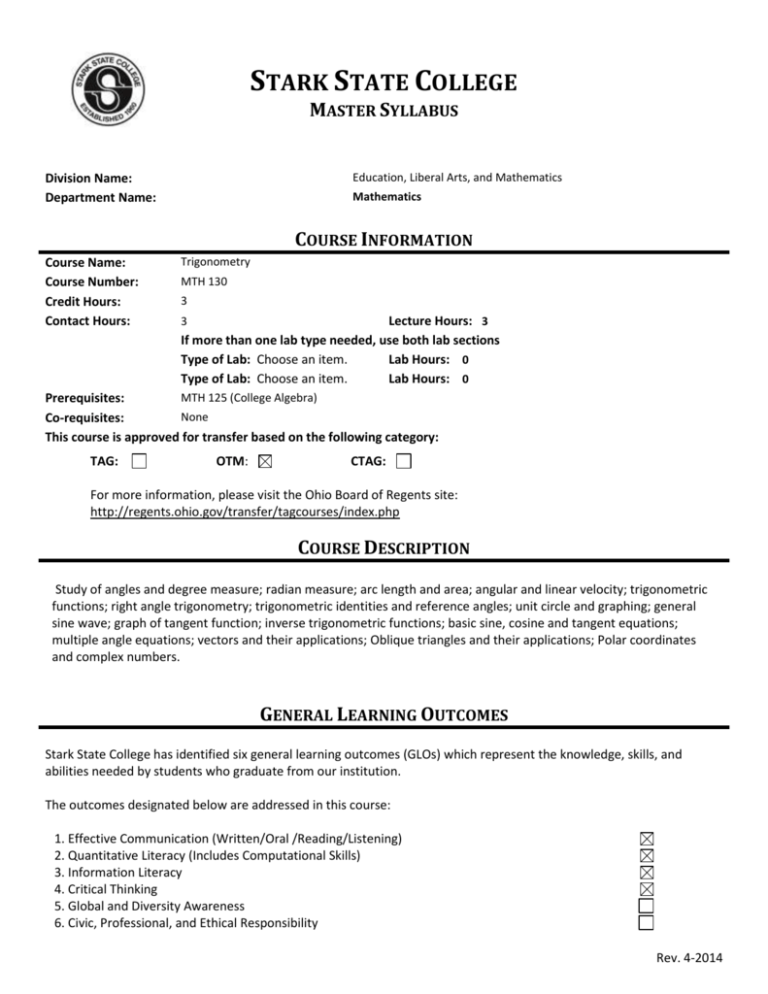
STARK STATE COLLEGE MASTER SYLLABUS Education, Liberal Arts, and Mathematics Division Name: Department Name: Mathematics COURSE INFORMATION Course Name: Course Number: Credit Hours: Contact Hours: Trigonometry MTH 130 3 Lecture Hours: 3 If more than one lab type needed, use both lab sections Type of Lab: Choose an item. Lab Hours: 0 Type of Lab: Choose an item. Lab Hours: 0 3 MTH 125 (College Algebra) Prerequisites: None Co-requisites: This course is approved for transfer based on the following category: TAG: OTM: CTAG: For more information, please visit the Ohio Board of Regents site: http://regents.ohio.gov/transfer/tagcourses/index.php COURSE DESCRIPTION Study of angles and degree measure; radian measure; arc length and area; angular and linear velocity; trigonometric functions; right angle trigonometry; trigonometric identities and reference angles; unit circle and graphing; general sine wave; graph of tangent function; inverse trigonometric functions; basic sine, cosine and tangent equations; multiple angle equations; vectors and their applications; Oblique triangles and their applications; Polar coordinates and complex numbers. GENERAL LEARNING OUTCOMES Stark State College has identified six general learning outcomes (GLOs) which represent the knowledge, skills, and abilities needed by students who graduate from our institution. The outcomes designated below are addressed in this course: 1. Effective Communication (Written/Oral /Reading/Listening) 2. Quantitative Literacy (Includes Computational Skills) 3. Information Literacy 4. Critical Thinking 5. Global and Diversity Awareness 6. Civic, Professional, and Ethical Responsibility Rev. 4-2014 COURSE OBJECTIVES Upon successful completion of this course, students should be able to: 1. Angles & Trigonometric Functions: Determine whether angles are coterminal. Identify the quadrant in which an angle lies and the quadrant of the terminal side of an angle. Convert between decimal degrees and degreesminutes-seconds, and perform computations. Find the area of a sector of a circle. Solve linear and angular velocity problems. Find the exact function value given a point on the terminal side. Evaluate trigonometric functions and expressions. Evaluate inverse functions. Find the six trigonometric function values for acute angles as well as special angles (30°, 45°, and 60°). Apply the fundamental identity. Use reference angles to find the exact value of an expression and to find functions of a given angle. (GLO 1, 2, 3, 4). 2. Graphs of Trigonometric and Inverse Functions: Evaluate trigonometric functions using the unit circle. Find coordinates of translated points. Determine the coordinates of a point on the graph of a trigonometric function. Define periodic functions. Sketch the graph of trigonometric and inverse trigonometric functions. Find the amplitude, period, and phase shift to perform transformations of trigonometric functions. Write equations for translated trigonometric functions. (GLO 1, 2, 3, 4). 3. Identities: Prove trigonometric identities by applying the fundamental identities; the Pythagorean, reciprocal, and quotient identities. Verify trigonometric identities using the sum and difference, double and half angle, cofunction, even/odd, and product-to-sum and sum-to-product identities. Use the reduction formula. (GLO 1, 2, 3, 4). 4. Trigonometric Equations: Evaluate the compositions of trigonometric and inverse trigonometric functions. Solve trigonometric equations for angles expressed as real numbers and as degrees. Solve trigonometric equations for an indicated variable. Find the inverse of a trigonometric function and state the domain and range. Solve trigonometric multiple-angle equations in degrees and radians. Solve trigonometric equations by using factoring and identities. (GLO 1, 2, 3, 4). 5. Applications of Trigonometry: Derive the Law of Sines and Cosines and use them to solve oblique triangles. Find the area of triangles and regions. Use Heron's formula. Use graphs to draw and identify vectors. Find magnitudes and direction angles for vectors. Find the component form of a vector. Graphically and algebraically perform vector operations: addition, subtraction, and scalar multiplication. Find angles between vectors. Determine if vectors are parallel, perpendicular, or neither. Write vectors as linear combinations of unit vectors. Solve applications. (GLO 1, 2, 3, 4). 6. Complex Numbers and Polar Coordinates: Perform operations on complex numbers. Find the product of a complex number and its conjugate. Evaluate functions using complex numbers. Convert complex numbers from standard form to trigonometric form, and vice versa. Perform operations on complex numbers in trigonometric form. Use De Moivre's theorem to simplify expressions in trigonometric form (or after converting to trigonometric form). Find roots of complex numbers in trigonometric or standard form. Find all complex solutions to equations. Convert to polar coordinates as well as rectangular coordinates. Sketch graphs of polar equations. Write equivalent rectangular equations for polar equations and vice versa. Graph parametric equations in the rectangular coordinate system. Write parametric equations for graphs. (GLO 1, 2, 3, 4). Rev. 4-2014 STARK STATE COLLEGE POLICIES Please refer to the Policies and Procedures manual on mystarkstate for more information on all college policies and procedures: Honesty in Learning Withdrawal Attendance Student Complaint Incomplete Grade Appeal Standards of Academic Progress DISABILITY SERVICES The Disability Support Services (DSS) Office offers a variety of services and accommodations to students with disabilities based on appropriate documentation, nature of the disability, and academic need. In order to initiate services, students should meet with the DSS Coordinator early in the semester to discuss their needs. The DSS Coordinator determines specific accommodations and services. If a student with a disability does not request accommodations through the DSS Coordinator, the instructor is under no obligation to provide accommodations. You may contact the DSS Coordinator at 330-966-5450, ext. 4423, or schedule an appointment in the Admissions Office, 3rd floor, Student Services Center. COMPUTER USAGE Students are expected to observe the Student Computer Usage Guidelines concerning the appropriate use of computers at the College. The guidelines are posted in all areas where computers are located, and individuals may obtain copies in the Admissions Office (S303) or on the SSC website under Student Computing (http://www.starkstate.edu/content/student-computing). Help Desk Services provides support for the following computer issues: questions regarding access to student accounts (login issues) connecting to a College resource connectivity issues with ANGEL (LMS - learning management system) using mystarkstate tools software questions campus laptop checkout reporting issues with computing or technical resources Help Desk Services is located in B219 on the Main campus. Contact them at 800-797-8275 (800-79-STARK), ext. 4357 (HELP). See the Help Desk website: http://www.starkstate.edu/helpdesk for hours and contact information. Rev. 4-2014


